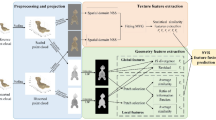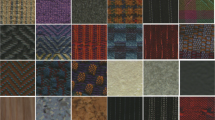Abstract
In light of the current problems including coarseness, visible cracks, difficult data organisation, and the expensive memory requirements of the current texture methods, this paper mainly focuses on efficient organisation, linearised memory compression and seamless texture mapping between scanned Citrus sinensis images and point cloud information. Position and colour gradient based top-down splitting is proposed to simplify and organise the texture as texel descriptors to avoid both over-simplification and under-simplification. A Quadtree Morton and Z-order based linearised coding strategy is presented to compress the memory space of our texel descriptor based texture. A Gaussian Markov random field scheme was designed to smooth the ‘cracks’ between neighbouring texels. The simulated results on eight Citrus sinensises show that our simplification method reduces the texture memory requirements by 81.3 % over the original image, and 50 % over conventional simplification. The compression scheme also showed a 61.7 % improvement over the ordinary Morton code. Finally, the Gaussian Markov random field scheme makes the texture mapping smoother in comparison with other methods.











Similar content being viewed by others
References
Adams B et al (2004) Interactive 3D painting on point-sampled objects[C]. in Eurographics Symposium on Point-Based Graphics. Citeseer
Catmull EE (1974) A subdivision algorithm for computer display of curved surfaces (No. UTEC-CSC-74-133)[J]. UTAH UNIV SALT LAKE CITY SCHOOL OF COMPUTING
Chan R et al (2013) An adaptive strategy for the restoration of textured images using fractional order regularisation[J. Numer Math: Theory Methods Appl 6(01):276–296
Clarenz U, M Rumpf and A. Telea (2004) Finite elements on point based surfaces[C]. in Proc. Eurographics Symp. Point-Based Graphics
Digne J et al (2014) Feature-preserving surface reconstruction and simplification from defect-laden point sets[J. J Math Imaging Vision 48(2):369–382
Gross M and H Pfister (2011) Point-based graphics. Morgan Kaufmann
Kennel P, Fiorio C, and Borne F (2015) Supervised image segmentation using Q-shift dual-tree complex wavelet transform coefficients with a texton approach[J]. Pattern Anal Applic 1–11
Koyuncu B and Kullu K (2010) Development of an optical 3D scanner based on structured light[C]. in Proceedings of the 9th WSEAS international conference
Kraak MJ and Ormeling F (2011) Cartography: visualization of spatial data. Guilford Press
Lensch HP et al (2001) Image-based reconstruction of spatially varying materials. Springer
Liu WL, Zhao XP, Xu BG (2011) Application of constructing Three-dimensional Model Using Laser scanning technology[C]. Applied Mechanics and Materials. Trans Tech Publ 94:86–89
LU X-C et al (2007) 3D visualization modelling based on laser scanning data [J]. J Syst Simul 7:054
Magda S and Kriegman D (2003) Fast texture synthesis on arbitrary meshes[C]. in ACM SIGGRAPH 2003 Sketches & Applications. ACM
Pan R, Taubin G (2015) Colour adjustment in image-based texture maps[J. Graph Model 79:39–48
Quan YS, He MY (2005) Encoding Compression Algorithm of Linear Octree Based on Three-dimensional Point Cloud Data [J]. Appl Res Comput 8:023
Rabin J et al (2011) Wasserstein barycenter and its application to texture mixing[M], in Scale Space and Variational Methods in Computer Vision Springer p. 435–446
Raper J (2009) Geographic information science [J]. Annu Rev Info Sci Technol 43(1):1–117
Soler C, Cani M-P, Angelidis A (2002) Hierarchical pattern mapping [J]. ACM Trans Graph (TOG) 21(3):673–680
Stahlhut O (2005) Extending natural textures with multi-scale synthesis [J]. Graph Model 67(6):496–517
ter Haar FB, Veltkamp RC (2009) A 3D face matching framework for facial curves[J. Graph Model 71(2):77–91
Turk G (2001) Texture synthesis on surfaces[C]. in Proceedings of the 28th annual conference on Computer graphics and interactive techniques. ACM
Wei J, Tang J, Wu G (2013) Multi-resolution organisation and management of massive 3D seismic datavolume [J]. Prog Explor Geophys 49(3):240–244
Xiao CX et al (2006) Texture synthesis for point-sampled geometry based on global optimization [J]. Chinese J Comput-Chinese Edition- 29(12):2061
Xu W (2015) Demonstration of three gorges archaeological relics based on 3D–visualization technology, in Ninth International Symposium on Multispectral Image Processing and Pattern Recognition (MIPPR2015). International Society for Optics and Photonics. p. 98151 M–98151 M-8
Zhang Z, Cheng Zeng (2011). Design of RIA-Based Online Fitting Room System [J]. Computer Technology and Development, 10
Zhang J et al (2003) Synthesis of progressively-variant textures on arbitrary surfaces[C]. in ACM Transactions on Graphics (TOG). ACM
Zhao X et al (2008) 3D reconstruction method for large scale relic landscape from laser point cloud [J]. Geomatics Info Sci Wuhan Uni 33(7):684–687
Zwicker M (2003) Continuous reconstruction, editing, and rendering of pointsampled surfaces. PhD thesis, ETH Zürich, Zürich, Switzerland
Acknowledgment
The authors would like to thank the Fundamental Research Funds for the Central Universities (No. 2014YB067, 2452015199, 2452015195), the National High Technology Research and Development Program of China (863 Program.2013AA10230402), the National High Technology Research and Development Program of China (2013BAD15B02), the Scholarship Council and Scientific Research Foundation for Ph. D from Northwest Agriculture & Forest University of China (2014BSJJ060), for financial support provided.
Author information
Authors and Affiliations
Corresponding author
Rights and permissions
About this article
Cite this article
Yang, H., Chang, J., Geng, N. et al. Texture organisation and mapping on Citrus sinensis point cloud. Multimed Tools Appl 76, 14711–14732 (2017). https://doi.org/10.1007/s11042-016-3998-6
Received:
Revised:
Accepted:
Published:
Issue Date:
DOI: https://doi.org/10.1007/s11042-016-3998-6




